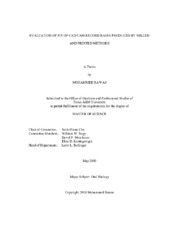| dc.contributor.advisor | Cho, Seok-Hwan | |
| dc.creator | Rawas, Mohammed | |
| dc.date.accessioned | 2019-10-16T21:06:21Z | |
| dc.date.available | 2021-05-01T12:33:51Z | |
| dc.date.created | 2019-05 | |
| dc.date.issued | 2019-04-03 | |
| dc.date.submitted | May 2019 | |
| dc.identifier.uri | https://hdl.handle.net/1969.1/185070 | |
| dc.description.abstract | Purpose: The purpose of the study was to evaluate the fit of two CAD/CAM record bases produced by milling and printing technology. Material and Methods: A total of 20 record bases were fabricated on an edentulous maxillary cast by milled (n=10) and printed (n=10) methods, then the intaglio surfaces of the specimens were spray coated and scanned by a laboratory scanner. The intaglio surfaces of the specimens were superimposed on the intaglio surface of the CAD record base digital file as a control group by using an inspection software program. Twelve anatomic locations were selected, and the deviation values of each location were calculated. The deviation area (%) within 200 µm was also calculated. The twelve anatomic locations then were divided into four location groups (anterior alveolar ridge, tuberosity, posterior palatal seal, and mid-palatal) and compared within each milled and printed group. A student’s t-test was performed for the percentage of the surface deviation and for the twelve anatomic locations. An ANOVA test was performed for the four location groups within each milled and printed group. A coefficient of variation test was done for the twelve location areas and for the four location groups. Results: There was a statistically significant difference of mean deviation of twelve anatomic locations between the milled (-82.5 ± 6.28 µm) and printed (-100.2 ±16.48 µm) groups (P< .001). The least fabrication distortion for the four location groups was the posterior palatal seal for both milled (56.2 ± 22 .2 µm) and printed (55.4 ± 76.6 µm) groups and the largest distortion location was in the anterior for both milled (-97.1 ± 35 µm) and printed (180.9 ± 60.3 µm) groups. The coefficient of variation for milled record bases is 7.6% and for printed record bases is 16.4%. The highest coefficient of variation was at tuberosity locations for milled record bases (43%) and in the posterior palatal seal location for printed record bases (138%). The lowest coefficient of variation was at the mid -palatal for milled record bases (26%) and in the anterior alveolar ridge for printed record bases (33%). Conclusions: Within the limitations of this in vitro study, there was a significant difference of record base fit between milled and printed fabrication methods. The milled record bases exhibited a significantly better fit than printed record bases. The best adaptation fit was found at the posterior palatal seal for both milled and printed groups, while the poorest adaptation was found in the anterior area for both groups. | en |
| dc.format.mimetype | application/pdf | |
| dc.language.iso | en | |
| dc.subject | fit | en |
| dc.subject | CAD/CAM record bases | en |
| dc.subject | milled record bases | en |
| dc.subject | printed record bases | en |
| dc.subject | denture | en |
| dc.title | Evaluation of Fit of CAD/CAM Record Bases Produced by Milled and Printed Methods | en |
| dc.type | Thesis | en |
| thesis.degree.department | Restorative Sciences | en |
| thesis.degree.discipline | Oral Biology | en |
| thesis.degree.grantor | Texas A & M University | en |
| thesis.degree.name | Master of Science | en |
| thesis.degree.level | Masters | en |
| dc.contributor.committeeMember | Nagy, William W | |
| dc.contributor.committeeMember | Murchison, David F | |
| dc.contributor.committeeMember | Kontogiorgos, Elias D | |
| dc.type.material | text | en |
| dc.date.updated | 2019-10-16T21:06:21Z | |
| local.embargo.terms | 2021-05-01 | |
| local.etdauthor.orcid | 0000-0002-7436-8196 | |


